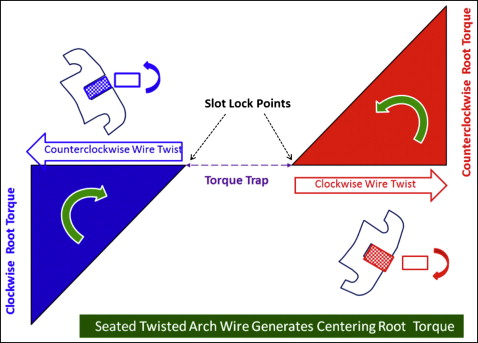Selecting custom torque prescriptions based on the treatment needs of each patient can reduce the amount of routine archwire torque adjustment needed and speed torque correction, thus reducing the total treatment time. Using the appropriate torque prescription prevents iatrogenic torque problems and allows most torque corrections to be done earlier with more resilient nickel-titanium and beta-titanium wires. As a result, fewer time-consuming final torque adjustments are needed with stainless steel finishing wires, resulting in shorter treatment time.
With judicious treatment planning, the clinical orthodontist using a straight wire appliance can reduce the need for routine torque adjustments. Molars needing torque can be uprighted early and accurately during treatment, and fewer routine final torquing adjustments will be needed at the end of treatment ( Figs 1 and 2 ).
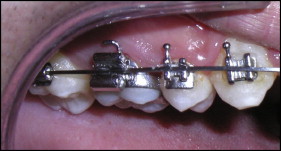
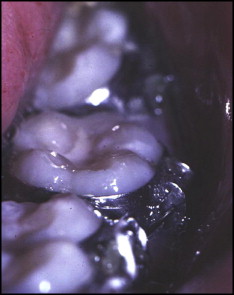
The straight-wire appliance was developed by Dr Larry Andrews of San Diego, Calif. This appliance incorporated slot inclination (torque), slot angulation (mesiodistal root tip), and first-order offsets (varied bracket base thickness) into individual brackets designed for each tooth in the arch. This innovation made it possible not only to level with unadjusted round nickel-titanium wires but also to continue leveling with flat unadjusted rectangular wires. This appliance concept greatly reduced the amount of routine wire bending needed for the average patient. The torque prescription values incorporated were developed from Andrews’ research with 120 untreated normal occlusions ( Table I ).
| Tooth | Central incisor | Lateral incisor | Canine | First premolar | Second premolar | First molar | Second molar |
|---|---|---|---|---|---|---|---|
| Maxilla | +7 | +3 | −7 | −7 | −7 | −9 | −9 |
| Mandible | −1 | −1 | −11 | −17 | −22 | −30 | −35 |
The straight-wire appliance made it possible to use flat, unadjusted rectangular nickel-titanium wires for generalized initial torque correction and control.
Accurate bracket placement is essential for an excellent tooth position outcome. Beyond that, the slot torque prescription in the bracket can be varied according to the direction of buccolingual root movement desired or to be prevented. Attention to torque values permits even more accurate leveling and early torque control than is possible with the basic Andrews’ torque values. By following up leveling with formable beta-titanium or stainless archwires, complete torque correction can be easily completed to the values chosen by the practitioner.
Any bracket can rotate freely about a rectangular archwire until the wire becomes locked against the bracket slot walls (slot lock). The total amount of free rotation for each tooth crown, from lock point to lock point, is twice the amount of nominal slot play ( Figs 3 and 4 , Table II ). Since the bracket can rotate about the archwire in 2 opposite directions, 2 slot lock points are created. Every combination of archwire shape and specified slot size has a slot play for that particular combination. These data are not easily available from manufacturers.
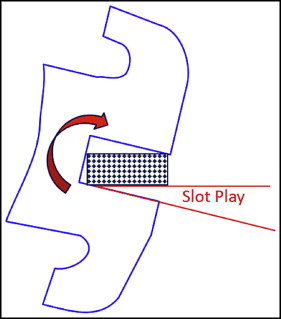
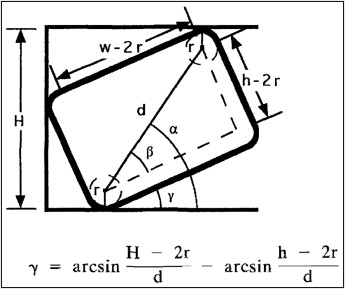
| Nominal wire size | 0.018 slot | 0.022 slot |
|---|---|---|
| 0.014 × 0.025 | 12.0 | 24.4 |
| 0.016 × 0.016 | 11.6 | Spin |
| 0.016 × 0.022 | 7.8 | 21.7 |
| 0.016 × 0.025 | 6.7 | 18.1 |
| 0.017 × 0.017 | 6.5 | 28.5 |
| 0.017 × 0.022 | 4.8 | 18.0 |
| 0.017 × 0.025 | 4.2 | 15.1 |
| 0.0175 × 0.0175 | 4.3 | 23.4 |
| 0.018 × 0.018 | 2.4 | 19.5 |
| 0.018 × 0.025 | 1.7 | 12.5 |
| 0.019 × 0.025 | X | 9.5 |
| 0.020 × 0.020 | X | 8.9 |
| 0.021 × 0.016 | X | 7.1 |
| 0.021 × 0.021 | X | 5.1 |
| 0.021 × 0.025 | X | 4.2 |
| 0.022 × 0.018 | X | 2.4 |
| 0.022 × 0.025 | X | 1.7 |
Meling et al published a formula for calculating slot play, taking into consideration (1) slot height (manufacturers make them larger than nominal size), (2) wire size (manufacturers make them slightly smaller than nominal size), and (3) edge rounding (corner radius) of the archwires (not usually disclosed by manufacturers).
For all teeth, the desired torque prescription calculations are based on the slot play of the final finishing or detailing archwire.
Ideally, the final finishing archwire will bring each tooth to its desired faciolingual angulation. To achieve this, the clinician must choose a torque prescription and wire size combination that will cancel out the slot play at the crown’s desired final inclination. The prescription depends on the direction of root movement during treatment. For any torque prescription and archwire combination, the resulting tooth position will be different if the tooth is moved labially than if it is moved lingually. Since the practitioner knows which direction the teeth will be moved, the torque prescription can be custom chosen to stop tooth movement at the desired crown inclination.
A bracket’s torque prescription value is the angle that the occlusal and gingival slot walls make with the plane of the bracket base. Angle’s original prescription was 0° for all teeth. Nominal values are the amount in degrees that the slot inclination deviates from Angle’s 0° orientation. By convention, a positive torque value essentially means that lingual root torque would be created by a large unadjusted rectangular wire; conversely, a negative torque value means that facial root torque would be created.
If a flat, unadjusted rectangular wire is placed in an edgewise slot and does not lock against the slot walls, it will provide no labiolingual forces on the tooth root (torque). If, on the other hand, the wire must be twisted before seating in the slot and remains twisted after ligation (slot locked), it will apply forces to the roots until the wire is no longer twisted ( Fig 5 ).

